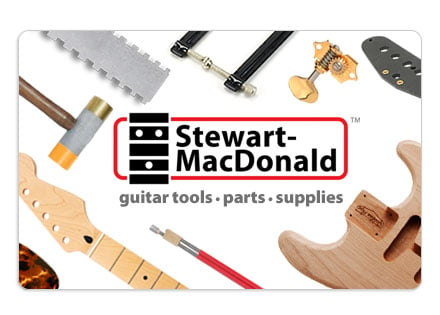How and what is measured to figure the fretboard radius?? What is the fretboard radius??? Ive seen the cone diagram and it still doesnt make sense to me.
Announcement
Collapse
No announcement yet.
Fretboard radius ???
Collapse
X
-
For a regular fretboard like on a Fender strat, picture the fretboard as being a segment cut lengthwise from the surface of a cylinder. On a Fender fretboard with a 9" radius, the cylinder it would be cut from would be 18" in diameter. So the board and the frets have a gentle convex curve that is the same as the outside of a cylinder with an 18" diameter, or 9" radius.
The conical diagram is used to illustrate a compound radius fretboard. For most J/C guitars, the fretboard would be a segment of the surface taken lengthwise from the part of the cone where the diameter is 24" (12" radius) to the part where the diameter is 32" (16" radius).
The way you measure a fretboard's radius is with radius gauges, which are just pieces of metal or plastic that have an edge that is cut to a curvature that would fit on the outside of a circle or cylinder of a certain radius. You put the gauges on the fretboard until you find the one that matches.
Last edited by dg; 03-05-2010, 11:52 PM.
-
The radius is how flat or curved the fingerboard is. Lower numbers mean more curve.
So your Jackson 12"-16" fingerboards gradually change from a 12" radius at the nut (more curved) to a flatter 16" radius at the last fret.
Since the strings lie along the plane of the neck's compound radius "cone", and this cone actually continues to flatten all the way to the bridge, your bridge radius could be set to say, 18" for lower/more even string action.
However, that's pretty flat, and you might find that it's harder to pick single notes on it. So depending on how you like your setup, you may or may not like it.
Comment
-
Take a 12" piece of string. Have one end in the center, one end tied to a pencil. Draw a circle with the pencil. The curve of the circle will be that of a 12" radius.
The smaller the circle radius, the more noticable the curve.
Do you notice the curve of the earth, or does it look flat? Big radius = flat.
Smaller radius = more comfort chording.
Larger radius = more shredding, faster and easier bends.
So, why not have a small radius by the head where you chord more, and a large by the body where you shred more? = compound radius. 12" to 16" at fret 12, the 16" to fret 22 or 24.
Comment
-
Originally posted by DonP View Post
Larger radius = more shredding, faster and easier bends.
That's the general perception, but for me a straight 10" is faster easier to bend, shred and chord.
but most all guitars today are flat as a wafer so i have to compromise -
it hampers my playing, and also is not very comfortable to my hands.
I think it's up to the individual.
Comment
-
Check this out...Originally posted by Twitch View PostHow and what is measured to figure the fretboard radius?? What is the fretboard radius??? Ive seen the cone diagram and it still doesnt make sense to me.
Yo Kramer Infinity Sustainer
Kramer Focus 3000
Jackson DR3
Washburn SB-8 T-Bird
Comment


Comment